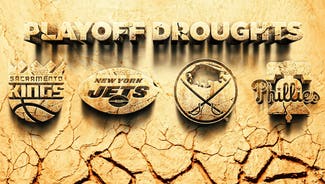
New overtime rule in minor-league hockey generating buzz

This rookie just may be called up from the American Hockey League after catching everyone's attention in an impressive debut.
Sorry, though, it's not the next Sidney Crosby, but a new overtime rule that should allow players like Crosby to showcase their skills even more with the game on the line.
The minor-league organization has long been the place to experiment with new directives, just to see how well they work -- or don't work -- before the NHL takes a look. Some (oversized blue lines) weren't popular. Others (not being able to change players after an icing call) have been promoted.
The new OT rule possibly could be coming soon to an NHL rink near you.
''It's certainly entertaining for fans and a lot of fun to watch,'' said David Andrews, the president and CEO of the AHL for the past 21 years.
Currently, the NHL uses a 4-on-4 OT model for five minutes. If no one scores, then it goes to a shootout.
But here's how the extra period works on the AHL level: It's seven minutes long -- or until someone scores, of course -- with the opening three minutes 4-on-4. Then, after the next whistle, it switches to 3-on-3 for the last four, leading to lots of room for creativity and scoring chances. If that doesn't decide things, it goes to a shootout, a concept that drives many a coach bonkers since it's almost like a skills competition.
That's the thing, though. This new overtime system has cut down significantly on shootouts.
Last year, the AHL had 65 percent of its OT games decided in a shootout, Andrews said. This season, it's shrunk to 25 percent.
Even more, of the 99 overtime games so far, 35 of them have been decided in 3-on-3 action.
Initially hesitant over the newfangled OT ordinance, Roy Sommer, the coach of the AHL Worcester Sharks, has warmed up to the idea. He thinks it would be a big hit with fans and players on the next level.
''If you put your three best NHL players against each other with all that ice and creativity, man, it would be something to watch,'' said Sommer, one of the all-time winningest AHL coaches. ''I know I wouldn't leave.''
As for when -- or even if -- this version of overtime arrives at the NHL level, that's hard to predict. In a statement, the NHL's hockey operations branch said the league follows ''the American Hockey League and other leagues closely. ... We're always interested in ways to make an already great game better.''
Colorado and Toronto had a 3-on-3 situation in overtime earlier this season after both teams drew penalties. It was riveting as players raced from end-to-end, unable to risk heading to the bench for fear of an odd-man rush going the other way.
''If we did this, there's no way games would go to a shootout,'' Colorado forward Matt Duchene said. ''As much as shootouts are fun to watch, I'm not a big fan of them, because it stinks to finish a game on a non-hockey play.
''But I'd love to see overtime 4-on-4 and then 3-on-3, because it would be amazing.''
Chris Wideman can attest to that. The defenseman for the Binghamton Senators has scored two of his 12 goals in overtime this season -- one in 3-on-3 and the other on a 4-on-3 power play.
''Lots of odd-man rushes, breakaways,'' explained Wideman, who's in his third season with the minor-league affiliate of Ottawa. ''From the pure entertainment side, you can't beat it. As far as for the players, it's a lot of fun for us. It gives you a chance to show off a little skill.''
One possible downside? More ice time for players, which could take its toll over an already grueling regular season.
NBC hockey analyst Eddie Olczyk wouldn't mind seeing something similar to college football's overtime rules. His suggestion is this: One team receives a 4-on-3 power play for two minutes and if it scores, then the opponent gets its chance. The one that stops the other wins.
''If we're trying to get away from the shootout, there are ways of trying to do that,'' said Olczyk, a former NHL player and coach.
Hey, maybe another test idea for the AHL. But the minor-league outfit isn't just a petri dish for the NHL. A lot of times, it's the AHL that institutes a rule that causes the NHL to take notice and later implement, like the delay penalty for flipping a puck over the glass in the defensive end. Or the trapezoid area behind the goal.
Or, maybe soon, this new OT rule.
''The fans love the shootout,'' Avs defenseman Erik Johnson said. ''But they'd love 3-on-3 in overtime.''

